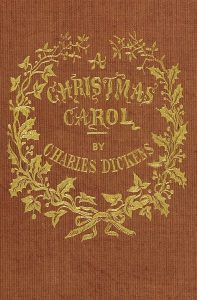
I have read this delightful little book every year at Christmas time for the last several years. Sometimes I come across things I’ve missed on previous readings. This year I noticed some things that have eluded me, and I hope to discuss a few of them during the holiday break. Today I’ll share an example of CHIASM in Dickens’ novel A Christmas Carol. “What is a chiasm?” you ask. We find this little device in Hebrew studies (I teach biblical languages, FYI) and tend to associate it with poetic style, but really, chiasms can appear in poetry or prose. (They also occur outside the Hebrew Bible!) Chiasm involves structuring a series of elements in an order, followed by matching elements in an inverse order (the elements could be semantic units or grammatical units). For ex., in Hebrew poetry, a chiasm’s elements could be represented in contiguous lines as follows: a b c // c′ b′ a′ (if 3 matching elements are present), or a b // b′ a′ (if only 2 matching elements are present). Here are a few exx. from the Hebrew Bible (in English translation):
Isa 22:22
He-shall-open and no one will shut, (a b)
he-shall-shut, and no one will open. (b′ a′)
Jer 2:19
Will-punish-you your-wickedness, (a b)
And-your-apostasies will-reprove-you. (b′ a′)
(Note: in line 1, ‘your-wickedness’ is the subject, but it follows the verb-direct object in Hebrew [contrary to standard English word order]. The Hebrew word order has been preserved in translation to demonstrate the chiasm.)
What I discovered in A Christmas Carol is that Dickens employs a brilliant SIX-element chiasm toward the end of the book to characterize the ringing of the bells of the churches–particularly, to describe the way old Scrooge is NOW able to hear the church bells for the first time–as a new man–since awaking from his haunting experiences. The chiasm is preceded by the description of the ringing as “the lustiest peals he had ever heard” and is followed by the exclamation “Oh, glorious, glorious!” In other words, in the past on Christmas day “old Scrooge” had surely heard these bells ringing throughout London, but he had never heard them like he did on this first Christmas following the encounter with the 3 Spirits (as “new Scrooge”). Here is the chiasm in context:
“I don’t know what day of the month it is!” said Scrooge. “I don’t know how long I’ve been among the Spirits. I don’t know anything. I’m quite a baby. Never mind. I don’t care. I’d rather be a baby. Hallo! Whoop! Hallo here!” He was checked in his transports by the churches ringing out the lustiest peals he had ever heard. Clash, clang, hammer; ding, dong, bell. Bell, dong, ding; hammer, clang, clash! Oh, glorious, glorious!
It’s fascinating to see Dickens introducing the climax of the whole story with this literary device. I’ve read through the book numerous times but never paused to notice it. The six elements occur in one order (Clash, clang, hammer; ding, dong, bell.), followed by its inversion (Bell, dong, ding; hammer, clang, clash!), for a total of *twelve* items forming the chiasm! Notice also that the punctuation is the same in the middle of each set (a semi-colon), but the end of the chiasm is punctuated differently (with an exclamation point!).
In graduate school, if someone found a Hebrew chiasm in the Old Testament he got to wear the proverbial blue ribbon for the day. Maybe someone else has noticed this chiasm in A Christmas Carol and even commented on it somewhere, but there is something quite enjoyable about seeing on one’s own a literary feature *and* being able to enjoy it for what it is. I’m aware that not everyone likes Dickens’ prose, but I think his writing style is tremendous.
